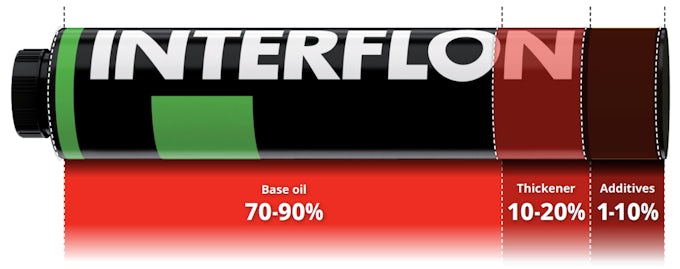How to match NLGI grade to your equipment’s operating conditions
Grease consistency: too soft, too stiff, or just right?
To explain consistency properly, it helps to first take a brief look at what grease actually is. Selecting the right grease is critical for reliability, energy efficiency and component life. One key property is consistency, the grease’s resistance to deformation. Too soft and it may leak or purge; too stiff and it may fail to reach the contact zone. In practice, grease is still sometimes chosen or swapped based on colour or habit, but colour is not a performance indicator. Selection should be based on NLGI grade, base oil viscosity, thickener type, additive package and operating conditions.
This article explains what grease is, how consistency is defined and measured, how NLGI grades relate to real applications, and what to consider when selecting the right grade for your equipment.

What is grease?
Grease is not just “thickened oil.” It is a blend of three components:
- Base oil – forms the lubricating film between moving parts.
- Thickener – holds the oil in place, giving structure and consistency.
- Additives – protect against wear, oxidation, corrosion and extreme pressure a.o.
Functions of the thickener
The thickener works like a sponge: holding the oil, releasing it under load, and reabsorbing it when pressure decreases. The amount and type of thickener affect:
- Consistency (soft vs. Firm)
- Temperature resistance
- Water resistance
- Compatibility with seals and materials
Key properties of grease
Important performance indicators include:
- Dropping point (temperature where grease becomes liquid)
- Pumpability in lubrication systems
- Load carrying capacity
- Shear stability under mechanical stress
- Water washout resistance
All are influenced by consistency.
NLGI grades explained
The National Lubricating Grease Institute (NLGI) created a scale to classify grease consistency, ranging from 000 (very fluid) to 6 (like hard cheddar).
Consistency is measured with the cone penetration test (ASTM D217): a cone is allowed to sink into the grease for 5 seconds. The depth of penetration defines the grade.

NLGI grades and uses
| NLGI grade | Consistency example | Typical uses | |
|---|---|---|---|
| 000–00 | Ketchup-like fluid | Gearboxes, central lubrication systems, cold storage conveyors | |
| 0–1 | Soft, like butter | Low-temperature bearings, food industry, winter conditions | |
| 2 | Peanut butter | General machinery, motors, pumps, conveyors | |
| 3–6 | Firm, like margarine to like hard cheddar | Sealed bearings, high-temp or slow heavy loads |
What to consider when selecting a grade
- Operating temperature – cold requires softer grease, hot requires stiffer grease.
- Bearing speed – fast-running machines prefer softer grades, slow or heavy-duty ones stiffer.
- Application type – lubrication systems need pumpable greases, manual greasing allows firmer ones.
- Environment – water, steam, cleaning agents or dust can all affect performance.
Common misconceptions
- Colour matters. False. Pigments only help identification. They do not affect performance.
- One grease fits all. Every application has its own load, speed and temperature requirements.
Conclusion
Consistency, expressed as NLGI grade, is a key parameter in grease selection. The correct grade ensures reliable film formation, prevents leakage and extends component life.
When combined with MicPol® technology, the right NLGI grade delivers both correct consistency and a durable protective film, resulting in longer lubrication intervals, reduced energy use and higher reliability compared to standard greases.
Want to know which grease best suits your machines? Contact us for a free consultation and learn how MicPol® technology can help extend intervals and cut costs.
Author: Janneke van der Pol, MLT I
Reviewed by: Frank van der Graaf, Technical Manager Interflon
Frequently Asked Questions
No. It’s common, not universal. In cold storage NLGI 2 can be too stiff to channel; in hot or heavy service, film thickness depends mainly on base-oil viscosity at operating temperature, not the NLGI number. Match consistency and viscosity to the duty.
Risky. Even with the same NLGI grade, incompatible thickeners/additives can cause oil separation, hardening or seal damage. Best practice: purge and clean before change-over and check compatibility tables.
No. Colour is a pigment for identification; it’s not a performance indicator. Results come from base oil, thickener chemistry, additives and NLGI grade. (A colour change during service can signal contamination or degradation.)
Typically 3–5 years in sealed, clean containers kept cool and dry, out of sunlight. Poor storage accelerates oil separation and oxidation. Use clear labelling and FIFO (6S) to maintain quality.
